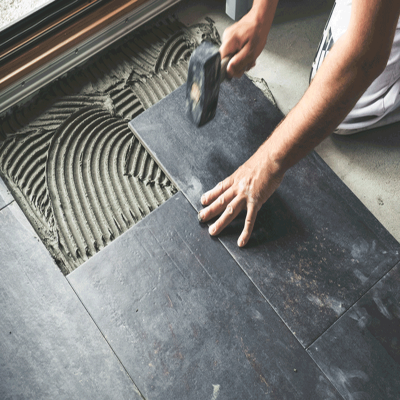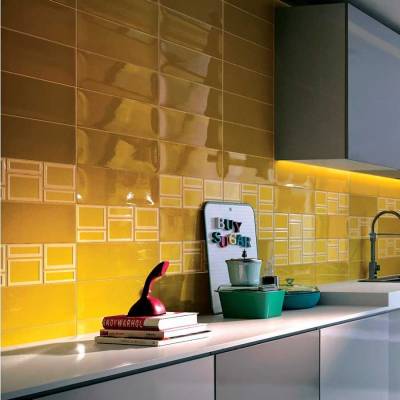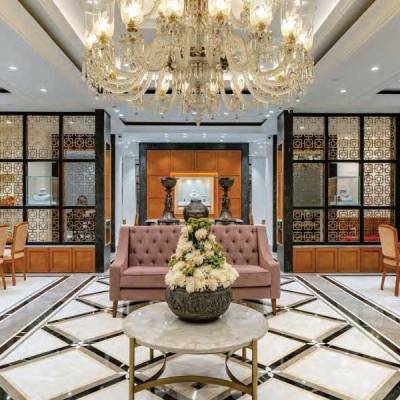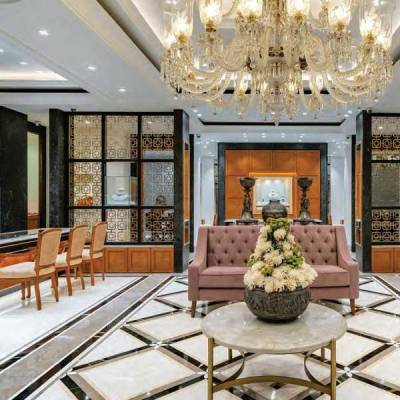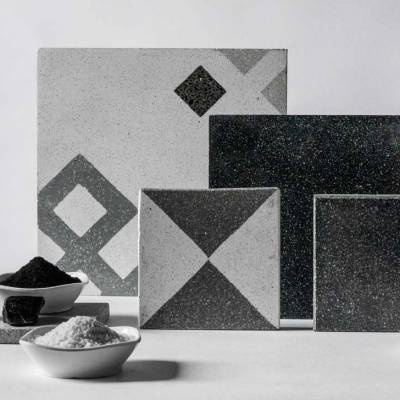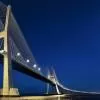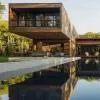- Home
- Building Material
- Tiles
- ZED Earth
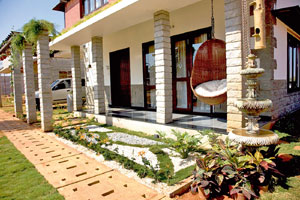
ZED Earth
A residential enclave in Bengaluru by Biodiversity Conservation India (BCIL), ZED Earth villa has recently received the SVAGRIHA 5-star rating. Developed on a built-up area of 3.30 lakh, ZED Earth has achieved an impressive 6,900 tonne of carbon savings through construction.
Post-occupancy, the company has even developed a programme to train local residents to ensure the project stays green over the years; that way, it expects 1,970 tonne of carbon savings per annum. Dr Chandrashekar Hariharan, Executive Chairman, Biodiversity India Conservation, shares the details of the company's ambitious green project with CW.
Conservation Camp
BCIL's main focus was to strike a fine balance between resident, ecological and resource needs. We have ensured absolute water, wastewater and solid waste management; as a consequence, Zed Earth is 100 per cent self-sufficient from the external grid in these areas. Although we are not fully independent of the grid for energy needs, we have achieved 70 per cent self-sufficiency.
The villas make use of low-flow fixtures that reduce building water demand by almost 74 per cent as compared to the SVAGRIHA base case. A rainwater storage tank of 1,500 litre capacity has been installed on site to capture and utilise rainwater. Up to 30 litre per day of fresh, clean water meets daily needs such as drinking and cooking.
Building blocks
The use of hollow blocks helps reduce the embodied energy of the building by about 40 per cent. The use of low-VOC and lead-free paints helps maintain good indoor air quality. Over 70 per cent of interior finishes are low-energy, like bamboo flooring, rough local granite, etc. We have consciously made use of manufactured sand instead of riverbed sand to manufacture the building blocks; this effort ensures that 10 sq km of riverbed is saved for every 1 million sq ft of construction that takes place on site. Also, 15-20 per cent of flyash content in the triple-blend concrete has been used to make the basic building blocks.
The use of natural stone for wall cladding and flooring in bathrooms instead of energy-intensive tile cladding ensures conservation of resources. Natural Cudappah stone was used to create chajjas (shafts) with no concrete or reinforcement. The site boundaries or perimeter were distinctly defined with prefab micro-concrete panels. Also, debris from the site has been reused within the site for backfilling and soling purposes. Almost 70 per cent of the total open area on site is soft paved and/or shaded under trees.
Energy efficiency
ZED Earth sets new standards for energy efficiency by installing wind turbines and solar panels to keep the enclave completely self-sustaining; 70 per cent of the total electricity for the villas is generated by renewable sources. Each villa sports a 1.5-kW solar panel system tied to the grid. Diesel generators are made available for backup power in all the projects. Gensets run on 20-30 per cent biodiesel fuel that comes from Jatropha or Pongamia plant oil. For domestic purposes, solar hot water systems are used to reduce electricity load by 50 per cent as against conventional geysers. Use of energy-efficient fixtures like CFLs, 40-W ceiling fans and optimised design reduces the total internal lighting consumption by 60 per cent, and 1.5 kW of wind turbine used in the township takes care of most of the external lighting load.
The green township promotes the use of only five-star rated appliances and equipment in individual houses. The green air-conditioning operates at 380 W, consuming 45-50 per cent less energy compared to conventional ACs that use 1.2 KW. These ACs are fitted with fresh air inlets that bring in fresh air once the CO2 sensors sense excess of the same. They also have ionisers that break down volatile compounds into simpler elements. Motion sensors are provided in all the villas as a part of an energy management scheme that turns off devices in the occupant's absence.
This green enclave has made optimal use of energy-efficient products and fixtures, which ensure a low carbon footprint. BCIL has installed water fixtures that work at less than 5 litre per minute; shower fixtures that work at less than 10 litre per minute; sewage treatment systems that ensure zero export of any water and 100 per cent upcycling; fans that work at 28 W instead of 75 W for regular fans; and air-to-water systems that convert atmospheric moisture into water without the need for fresh water.
Natural light
The architecture of the houses is such that it ensures the residents benefit from optimal natural light. Over 88 per cent of the total living area falls under the daylight zone. CFLs and LEDs have been used in these houses. The lighting power density is 4.78 W per sq m and thermal efficiency of the project is 289.82 sq ft per TR.
Also, solar photovoltaic panels of size 1.4 kWp and solar water heaters of 150 lpd capacity have been installed in the villas.
Every home has openings above the regular window area where a slit opens at 2.6 m enhancing the lighting inside a room by as much as 40 per cent. We have planned spaces in such a way that there are openings and fenestrations that allow cross reflection of light across the house. Fenestrations and floor plan layouts have been designed to facilitate natural ventilation through all spaces. Fenestration design of the villa reduces direct incident heat penetration by about 38 per cent, as compared to the SVAGRIHA base case for Bengaluru.
Ventilated spaces
The moderate weather in Bengaluru has ensured pleasant climatic conditions in this township. Natural ventilation, coupled with ZED energy-efficient, air-conditioning systems, maintains steady temperature in the houses. All the vents in the houses have been created after assessing local wind patterns. Ventilators are provided to each and every room.
The arrangement of spaces and openings has been planned in such a manner that it allows for stack ventilation and maintains cooler surroundings. The internal distribution of spaces ensures that 90 per cent of buffer spaces have been provided in the eastern and western facades of the villa. Bio-walls have been installed on both sides of the villa with an opening to the dining and living areas.
Living green
Building a green structure is half the battle won; it also has to be validated by the occupants. We have designed a programme over many years that will help ZED residents occupy green and then live green. This is admittedly a challenge that is difficult in some ways, if not daunting.
BCIL has also developed a Build, Live, Occupy Green (BLOG) programme, which is a continuous and dynamic process that explains to occupants the different aspects of going green. Essentially, the idea is to make people understand that the solution for energy deficits in the future is not energy generation but energy efficiency. Part of this programme is a unique 'Zediquette' manual, the etiquette of energy use in ZED homes.
This programme makes an attempt to educate men, women and children on what standby power means and how to curb power wastage. For example, how an air-conditioner rated at 1.2 kW, when on standby mode, consumes up to 30 per cent of the energy of a regular air-conditioner, and therefore up to 300 W of energy, even when it isn't switched on. Such 'ghost power' consumption applies to mixers, televisions, grinders, and such other heavy-duty appliances that people use in a house, resulting in power wastage.
R Hariharan's perspective
"India's energy deficits are only going to rise. We are moving into an era of grid-free energy where solutions for energy generation will be local. This has already happened on our ZED campuses for water and waste management. There is not even a single litre of wastewater exported from our campuses. Similarly, there is zero export of wet waste. There is 100 per cent upcycling of all treated water for reuse and 100 per cent conversion of all wet waste generated into compost. In the past year, over quarter million square feet of buildings have gone for certification from different rating agencies. This figure is against a total of 1.3 billion sq ft of such certified homes that we have now in India, since the time it began in 2001. The rise in the past year alone is significant. All estimates suggest that the second billion sq ft of such green buildings certified will be reached by 2015. This figure, I must admit, is only 3 per cent of total buildings that are being created."
Project details:
Size of the project: Phase-I: 18 x 15 m (18 x 12, 18 x 21), 44 villas; Phase-II: 18 x 23, Icon Classic, Casablanca, 103 villas
Project completion date: Model villa by Feb 2011, Completion of entire Phase-I by May 2013
Year of certification: 2012
Building materials sourced: From Karnataka (majority within 90 km) Contractor, architects/planners, green consultant: Biodiversity Conservation India. Tel: 080-4018 4018. Website: www.zed.in
Structural consultant: BMS College of Engineering. Tel: 080-2662 2130. Fax: 080-2661 4357. Website: www.bmsce.in
Lights: Havells. Tel: 0120-477 1000. Fax: 0120-477 2000. Website: www.havells.com
Air conditioners: ZED AC. Website: www.zed-air.ca
Roofing: Monier Tiles. Tel: 080-4126 8116. Website: www.monier.in
Glazing: Saint Gobain. Tel: 044-2716 2832. Website: www.saint-gobain.co.in
Paints: Asian Paints. Tel: 022-3981 8000. Fax: 022-3981 8888. Website: www.asianpaints.com
Painting contractor: Sai Enterprises. Govindraj. Mobile: (0) 98863 92559.
Cement: Srinivas Agencies. Mobile: (0) 98452 72031.
Would you like to share details of any green initiative? Write in at feedback@ASAPPmedia.com
Sprawling across 24 acre, Zed Earth, a green residential enclave developed by Biodiversity Conservation India Ltd, has recently received the SVAGRIHA five-star rating. A residential enclave in Bengaluru by Biodiversity Conservation India (BCIL), ZED Earth villa has recently received the SVAGRIHA 5-star rating. Developed on a built-up area of 3.30 lakh, ZED Earth has achieved an impressive 6,900 tonne of carbon savings through construction. Post-occupancy, the company has even developed a programme to train local residents to ensure the project stays green over the years; that way, it expects 1,970 tonne of carbon savings per annum. Dr Chandrashekar Hariharan, Executive Chairman, Biodiversity India Conservation, shares the details of the company's ambitious green project with CW. Conservation Camp BCIL's main focus was to strike a fine balance between resident, ecological and resource needs. We have ensured absolute water, wastewater and solid waste management; as a consequence, Zed Earth is 100 per cent self-sufficient from the external grid in these areas. Although we are not fully independent of the grid for energy needs, we have achieved 70 per cent self-sufficiency. The villas make use of low-flow fixtures that reduce building water demand by almost 74 per cent as compared to the SVAGRIHA base case. A rainwater storage tank of 1,500 litre capacity has been installed on site to capture and utilise rainwater. Up to 30 litre per day of fresh, clean water meets daily needs such as drinking and cooking. Building blocks The use of hollow blocks helps reduce the embodied energy of the building by about 40 per cent. The use of low-VOC and lead-free paints helps maintain good indoor air quality. Over 70 per cent of interior finishes are low-energy, like bamboo flooring, rough local granite, etc. We have consciously made use of manufactured sand instead of riverbed sand to manufacture the building blocks; this effort ensures that 10 sq km of riverbed is saved for every 1 million sq ft of construction that takes place on site. Also, 15-20 per cent of flyash content in the triple-blend concrete has been used to make the basic building blocks. The use of natural stone for wall cladding and flooring in bathrooms instead of energy-intensive tile cladding ensures conservation of resources. Natural Cudappah stone was used to create chajjas (shafts) with no concrete or reinforcement. The site boundaries or perimeter were distinctly defined with prefab micro-concrete panels. Also, debris from the site has been reused within the site for backfilling and soling purposes. Almost 70 per cent of the total open area on site is soft paved and/or shaded under trees. Energy efficiency ZED Earth sets new standards for energy efficiency by installing wind turbines and solar panels to keep the enclave completely self-sustaining; 70 per cent of the total electricity for the villas is generated by renewable sources. Each villa sports a 1.5-kW solar panel system tied to the grid. Diesel generators are made available for backup power in all the projects. Gensets run on 20-30 per cent biodiesel fuel that comes from Jatropha or Pongamia plant oil. For domestic purposes, solar hot water systems are used to reduce electricity load by 50 per cent as against conventional geysers. Use of energy-efficient fixtures like CFLs, 40-W ceiling fans and optimised design reduces the total internal lighting consumption by 60 per cent, and 1.5 kW of wind turbine used in the township takes care of most of the external lighting load. The green township promotes the use of only five-star rated appliances and equipment in individual houses. The green air-conditioning operates at 380 W, consuming 45-50 per cent less energy compared to conventional ACs that use 1.2 KW. These ACs are fitted with fresh air inlets that bring in fresh air once the CO2 sensors sense excess of the same. They also have ionisers that break down volatile compounds into simpler elements. Motion sensors are provided in all the villas as a part of an energy management scheme that turns off devices in the occupant's absence. This green enclave has made optimal use of energy-efficient products and fixtures, which ensure a low carbon footprint. BCIL has installed water fixtures that work at less than 5 litre per minute; shower fixtures that work at less than 10 litre per minute; sewage treatment systems that ensure zero export of any water and 100 per cent upcycling; fans that work at 28 W instead of 75 W for regular fans; and air-to-water systems that convert atmospheric moisture into water without the need for fresh water. Natural light The architecture of the houses is such that it ensures the residents benefit from optimal natural light. Over 88 per cent of the total living area falls under the daylight zone. CFLs and LEDs have been used in these houses. The lighting power density is 4.78 W per sq m and thermal efficiency of the project is 289.82 sq ft per TR. Also, solar photovoltaic panels of size 1.4 kWp and solar water heaters of 150 lpd capacity have been installed in the villas. Every home has openings above the regular window area where a slit opens at 2.6 m enhancing the lighting inside a room by as much as 40 per cent. We have planned spaces in such a way that there are openings and fenestrations that allow cross reflection of light across the house. Fenestrations and floor plan layouts have been designed to facilitate natural ventilation through all spaces. Fenestration design of the villa reduces direct incident heat penetration by about 38 per cent, as compared to the SVAGRIHA base case for Bengaluru. Ventilated spaces The moderate weather in Bengaluru has ensured pleasant climatic conditions in this township. Natural ventilation, coupled with ZED energy-efficient, air-conditioning systems, maintains steady temperature in the houses. All the vents in the houses have been created after assessing local wind patterns. Ventilators are provided to each and every room. The arrangement of spaces and openings has been planned in such a manner that it allows for stack ventilation and maintains cooler surroundings. The internal distribution of spaces ensures that 90 per cent of buffer spaces have been provided in the eastern and western facades of the villa. Bio-walls have been installed on both sides of the villa with an opening to the dining and living areas. Living green Building a green structure is half the battle won; it also has to be validated by the occupants. We have designed a programme over many years that will help ZED residents occupy green and then live green. This is admittedly a challenge that is difficult in some ways, if not daunting. BCIL has also developed a Build, Live, Occupy Green (BLOG) programme, which is a continuous and dynamic process that explains to occupants the different aspects of going green. Essentially, the idea is to make people understand that the solution for energy deficits in the future is not energy generation but energy efficiency. Part of this programme is a unique 'Zediquette' manual, the etiquette of energy use in ZED homes. This programme makes an attempt to educate men, women and children on what standby power means and how to curb power wastage. For example, how an air-conditioner rated at 1.2 kW, when on standby mode, consumes up to 30 per cent of the energy of a regular air-conditioner, and therefore up to 300 W of energy, even when it isn't switched on. Such 'ghost power' consumption applies to mixers, televisions, grinders, and such other heavy-duty appliances that people use in a house, resulting in power wastage. R Hariharan's perspective "India's energy deficits are only going to rise. We are moving into an era of grid-free energy where solutions for energy generation will be local. This has already happened on our ZED campuses for water and waste management. There is not even a single litre of wastewater exported from our campuses. Similarly, there is zero export of wet waste. There is 100 per cent upcycling of all treated water for reuse and 100 per cent conversion of all wet waste generated into compost. In the past year, over quarter million square feet of buildings have gone for certification from different rating agencies. This figure is against a total of 1.3 billion sq ft of such certified homes that we have now in India, since the time it began in 2001. The rise in the past year alone is significant. All estimates suggest that the second billion sq ft of such green buildings certified will be reached by 2015. This figure, I must admit, is only 3 per cent of total buildings that are being created." Project details: Size of the project: Phase-I: 18 x 15 m (18 x 12, 18 x 21), 44 villas; Phase-II: 18 x 23, Icon Classic, Casablanca, 103 villas Project completion date: Model villa by Feb 2011, Completion of entire Phase-I by May 2013 Year of certification: 2012 Building materials sourced: From Karnataka (majority within 90 km) Contractor, architects/planners, green consultant: Biodiversity Conservation India. Tel: 080-4018 4018. Website: www.zed.in Structural consultant: BMS College of Engineering. Tel: 080-2662 2130. Fax: 080-2661 4357. Website: www.bmsce.in Lights: Havells. Tel: 0120-477 1000. Fax: 0120-477 2000. Website: www.havells.com Air conditioners: ZED AC. Website: www.zed-air.ca Roofing: Monier Tiles. Tel: 080-4126 8116. Website: www.monier.in Glazing: Saint Gobain. Tel: 044-2716 2832. Website: www.saint-gobain.co.in Paints: Asian Paints. Tel: 022-3981 8000. Fax: 022-3981 8888. Website: www.asianpaints.com Painting contractor: Sai Enterprises. Govindraj. Mobile: (0) 98863 92559. Cement: Srinivas Agencies. Mobile: (0) 98452 72031. Would you like to share details of any green initiative? Write in at feedback@ASAPPmedia.com


